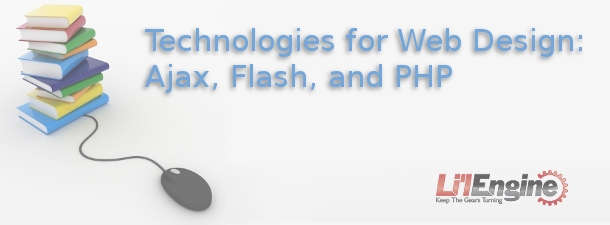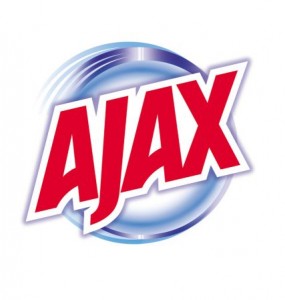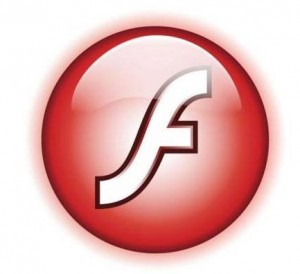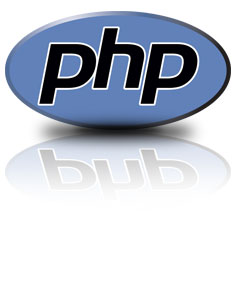Technologies for Web Design: Ajax, Flash, and PHP

Fortunately, to have a great website today you don’t have to be an HTML wizard or have mad programming skills. There are plenty of technologies for web design that let you have a dynamic or interactive interface on your web pages. Four of those technologies are Ajax, Flash, PHP, and ASP.
 Ajax is short for asynchronous JavaScript and XML. It is a group of web development techniques that are used to create interactive web apps. Using Ajax, web applications can, for example, retrieve data from the server in the background without changing the display and behavior of the page the user is on. XML is not technically required, and the requests from the servers do not have to be asynchronous.
Ajax is short for asynchronous JavaScript and XML. It is a group of web development techniques that are used to create interactive web apps. Using Ajax, web applications can, for example, retrieve data from the server in the background without changing the display and behavior of the page the user is on. XML is not technically required, and the requests from the servers do not have to be asynchronous.
But it’s the asynchronous aspect of Ajax that people love. In standard web apps, interaction has to happen on a step by step basis in a frustrating game of click and wait. But with Ajax, the JavaScript that’s loaded as the page loads handles data validation and manipulation without a trip to the server and back. While it’s changing the display based on a visitor click, it’s sending data back and forth to the server, but the data transfer doesn’t depend on the customer’s actions. The result: almost total elimination of the slow click-wait cycle.
Ajax uses a combination of HTML and CS for creating and styling information. It is, in short, used so that web pages feel more responsive by exchanging small quantities of data with the server while working in the background, so the web page doesn’t have to be reloaded whenever the user requests a change. This goes a long way to speed up the page and make it more user-friendly. That’s because instead of having entire applications posted back to a server, you can have only a small part of the page update independently of the rest of the page. Bottom line: visitors will hate you if you make it so the page has to reload every time they respond to an on-page interactive component.
 Flash is used to add, well, flash to your website. It isn’t easy to learn to write good animations using Flash, so sometimes developers learn to use Flash and then feel like they have to use it everywhere to justify having spent so much time learning it. But you have to be careful with Flash because there are drawbacks to using it. For one thing, search engines have a hard time crawling websites that heavily use Flash graphics, so it’s hard to rank high with an all-Flash website. So it’s not a good idea to use Flash just because you can.
Flash is used to add, well, flash to your website. It isn’t easy to learn to write good animations using Flash, so sometimes developers learn to use Flash and then feel like they have to use it everywhere to justify having spent so much time learning it. But you have to be careful with Flash because there are drawbacks to using it. For one thing, search engines have a hard time crawling websites that heavily use Flash graphics, so it’s hard to rank high with an all-Flash website. So it’s not a good idea to use Flash just because you can.
Whether using Flash is a good or bad choice depends on what your site is for. Flash is best suited as an animation tool, and it’s supported on almost all the web browsers that people use, so you can be pretty sure that if you build a site with a Flash plugin, visitors will see it as you intended it to be seen. Video is a good Flash application because it doesn’t require a plugin like Windows MediaPlayer, and Flash is good for games, because it has better browser support than Ajax. Also, vector graphics look prettier in Flash, and it allows image replacement for special fonts on a site.
On the other hand, unless Flash is optimized for a site, Flash applications can be big and take a long time to load. Sometimes the entire Flash site has to be loaded before it can even be used. People hate this. And frankly, that little graphical countdown clock is small consolation to those waiting to use a site.
Flash usually disables the browser’s “back” button. That means that if a user clicks it while deep in the bowels of a Flash site, they’re taken to the website they were on before they got to the Flash site. If they want to return to the Flash site, they have to re-navigate back to where they were on the Flash site. Face it: the average web surfer has the attention span of a gnat on crack and probably isn’t going to go to all that trouble twice.
 PHP (which stands for hypertext preprocessor) is a scripting language that is open-source so that users have access to the source code and can build, extend, or otherwise customize it for their own use. PHP mostly works as a filter, as it takes input from a stream or a file containing text and / or PHP scripts and outputs another data stream. Usually the output is HTML. While it was originally designed to make dynamic web pages, PHP focuses mainly on server-side scripting now. This is basically a way of making web pages interactive. PHP is also popular in the development of frameworks that provide the structure for rapid application development in which apps are written as they are being planned, making it easier to crank apps out faster.
PHP (which stands for hypertext preprocessor) is a scripting language that is open-source so that users have access to the source code and can build, extend, or otherwise customize it for their own use. PHP mostly works as a filter, as it takes input from a stream or a file containing text and / or PHP scripts and outputs another data stream. Usually the output is HTML. While it was originally designed to make dynamic web pages, PHP focuses mainly on server-side scripting now. This is basically a way of making web pages interactive. PHP is also popular in the development of frameworks that provide the structure for rapid application development in which apps are written as they are being planned, making it easier to crank apps out faster.
There are lots of other technologies for web design besides Ajax, Flash, and PHP, but these are three that are common. If you want to learn the basics of Ajax, go to http://www.learn-ajax-tutorial.com/. To learn more about Flash, go to http://www.w3schools.com/Flash/default.asp. If you’re interested in learning PHP, then try http://devzone.zend.com/article/627. While these are designed to make your site faster and more attractive and fun to visit, they aren’t the whole picture. Without content, the prettiest site in the world isn’t going to keep people coming back.







